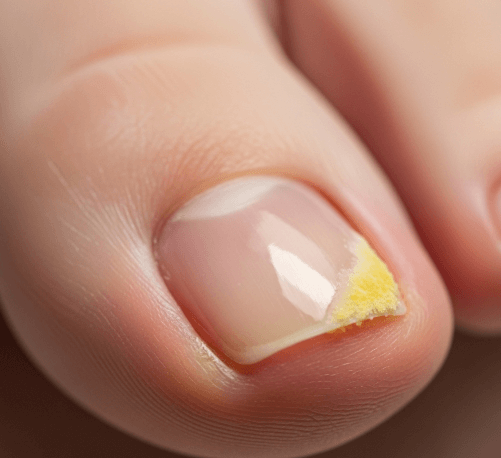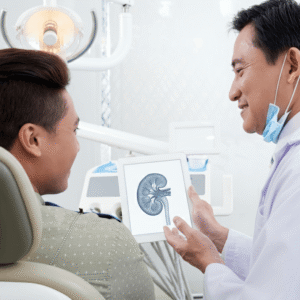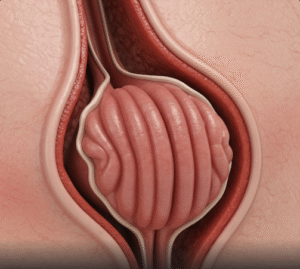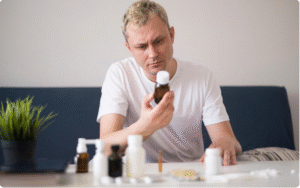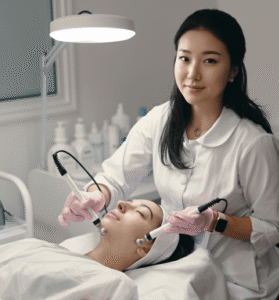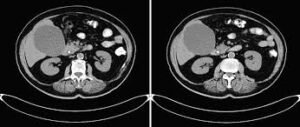What it is
➝ Onychomycosis is a fungal infection of the toenails or fingernails, most often caused by dermatophytes (Trichophyton species), but sometimes by yeasts or non-dermatophyte molds.
➝ It leads to thickened, discolored, brittle, and distorted nails, often accompanied by discomfort or embarrassment.
➝ Pulse terbinafine therapy is a systemic antifungal treatment in which terbinafine is given intermittently (in cycles) rather than continuously.
➝ This regimen offers effective nail penetration while reducing drug exposure, improving safety, cost, and patient adherence.
Why it’s done
→ To clear nail fungal infection and restore healthy nail growth.
→ To avoid prolonged continuous dosing of terbinafine, which may increase risks of liver side effects.
→ To improve compliance, since pulse therapy involves taking medication for short periods followed by rest phases.
→ To treat patients with multiple nails affected, severe nail thickening, or failed topical therapies.
→ In Korea, pulse terbinafine is a commonly used approach due to its balance of efficacy and safety.
Alternatives
→ Continuous terbinafine therapy: 250 mg daily for 6 weeks (fingernails) or 12 weeks (toenails).
→ Other systemic antifungals:
- Itraconazole (also used in pulse regimens).
- Fluconazole (less common, longer courses).
→ Topical treatments: Efinaconazole solution, ciclopirox lacquer, amorolfine (less effective alone for severe cases, but used for mild disease or in combination).
→ Laser therapy: Nd:YAG or diode laser (adjunctive, variable effectiveness).
→ Mechanical or chemical debridement: Filing, urea-based softening agents, often used with antifungals.
Preparation
→ Diagnosis confirmation with nail clippings, KOH test, or fungal culture is recommended before systemic treatment.
→ Baseline liver function tests are performed, as terbinafine is metabolized in the liver.
→ Patients are counseled about the importance of adherence to pulse cycles and nail hygiene.
→ In Korea, dermatology clinics often combine lab testing and education sessions before initiating systemic antifungal therapy.
How it’s Done
→ Typical pulse terbinafine regimen:
- 250 mg daily for 1 week per month, repeated for 3–4 months (depending on nail severity and number of nails affected).
- Rest of the month: no medication.
→ For toenail infections, 3–4 pulses are usually required.
→ For fingernail infections, 2 pulses may be sufficient.
→ The drug remains in the nail keratin for months, continuing to act even during off-weeks.
→ Patients are also advised to use topical antifungal nail solutions and practice proper nail hygiene to enhance results.
→ In Korean dermatology clinics, pulse therapy is often paired with professional nail debridement or laser treatments for faster improvement.
Recovery
→ Early improvement in nail appearance is visible after 8–12 weeks, though full clearance takes 6–12 months, as nails grow slowly.
→ Fingernails typically grow out faster (about 4–6 months), while toenails may take up to 12–18 months.
→ Pulse therapy helps reduce side effects, so patients usually tolerate it well.
→ Long-term cure rates are high when treatment is combined with ongoing nail care and antifungal maintenance.
Complications
→ Possible side effects of terbinafine:
- Gastrointestinal upset (nausea, diarrhea).
- Taste disturbances.
- Rare liver toxicity (hence the need for liver monitoring).
- Skin rash or allergic reaction.
→ Incomplete clearance if patients miss cycles or if non-dermatophyte organisms are present.
→ Recurrence if shoes, socks, or nail instruments are not disinfected.
Treatment Options in Korea
→ In Korea, pulse terbinafine therapy is a standard treatment for onychomycosis, widely used in dermatology and podiatry clinics.
→ Doctors typically combine pulse terbinafine with adjunct therapies, such as:
- Topical antifungal lacquers for enhanced penetration.
- Laser treatments (e.g., Nd:YAG laser) to speed fungal clearance.
- Nail debridement and thinning to allow better drug access.
→ Patients receive structured follow-up visits with nail photography to track progress.
→ Korean clinics also emphasize prevention of reinfection by disinfecting shoes, socks, and nail tools, and recommending antifungal sprays or powders.
→ Pulse terbinafine in Korea is considered safe, cost-effective, and practical, making it a leading systemic option for stubborn or extensive nail fungal infections.

